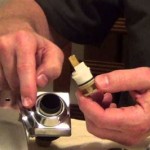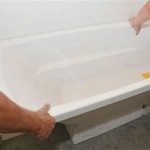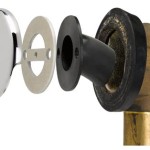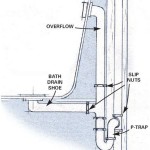Natural Cleaners for Bathtub Soap Scum Removal
Bathtub soap scum, a common household nuisance, presents a challenge for maintaining bathroom cleanliness. Traditional cleaning methods often involve harsh chemicals that can be detrimental to both the environment and human health. The buildup itself consists of a combination of soap residue, hard water minerals, body oils, and skin cells, forming a stubborn, grimy layer on bathtub surfaces. This article explores effective and environmentally friendly alternatives to commercial cleaners for removing bathtub soap scum, focusing on readily available natural ingredients and their application techniques.
Understanding Soap Scum Formation
To effectively combat soap scum, an understanding of its formation is crucial. Traditional soaps, unlike modern detergents, are typically made from fats and oils combined with an alkali, such as lye. When soap comes into contact with hard water, which contains high concentrations of minerals like calcium and magnesium, a chemical reaction occurs. This reaction results in the formation of insoluble salts, commonly known as soap scum. These salts precipitate out of the water and adhere to surfaces, creating the unsightly and difficult-to-remove buildup. Factors like frequency of use, water hardness, and the type of soap used all contribute to the rate and severity of soap scum accumulation.
Furthermore, the bathtub environment itself encourages soap scum formation. The warm, humid conditions promote the adhesion of the soap scum to the bathtub surface, making it more difficult to dissolve and remove. Over time, the layers of soap scum can harden and become increasingly resistant to standard cleaning methods. This buildup can also trap dirt, grime, and even mold, further complicating the cleaning process and potentially posing health risks.
Modern detergents, often referred to as synthetic detergents or syndets, are less prone to forming soap scum because they are designed to work equally well in hard and soft water. However, even with the use of detergents, some residue can still accumulate, particularly if the water is very hard or if cleaning is infrequent. Understanding these factors allows for a more targeted and effective approach to preventing and removing soap scum using natural cleaning methods.
Key Natural Cleaning Agents and Their Properties
Several natural substances possess cleaning properties that make them effective alternatives to harsh chemical cleaners for removing soap scum. These options are generally safer for the environment, less irritating to the skin and respiratory system, and often more economical than commercially produced cleaners. The primary agents discussed below are vinegar, baking soda, and lemon juice, each offering unique benefits and application methods.
Vinegar: White distilled vinegar is a mild acid, typically containing about 5% acetic acid. This acidity is what makes it effective at dissolving mineral deposits, including the calcium and magnesium compounds that form soap scum. Vinegar is also a natural disinfectant, helping to kill bacteria and mold that may be present in the bathtub. Its versatility and affordability make it a popular choice for general household cleaning, including soap scum removal. The odor of vinegar can be strong, but it dissipates quickly after cleaning. The acidic nature makes it unsuitable for use on natural stone surfaces like marble or granite, as it can etch and damage these materials.
Baking Soda: Sodium bicarbonate, commonly known as baking soda, is a mild abrasive and a natural deodorizer. Its slightly alkaline pH helps to neutralize acids, making it effective at loosening soap scum and grime. Baking soda can be used as a standalone cleaner or combined with other natural agents, such as vinegar, to create a more potent cleaning solution. Its gentle abrasiveness makes it suitable for scrubbing surfaces without causing significant damage. Baking soda is readily available, inexpensive, and safe for most surfaces, although it's generally advisable to test it on a small, inconspicuous area first.
Lemon Juice: Lemon juice, like vinegar, contains citric acid, which possesses cleaning and disinfecting properties. The acidity of lemon juice helps to dissolve soap scum and hard water stains. It also has a pleasant, fresh scent, which can help to neutralize unpleasant odors in the bathroom. Lemon juice can be used on its own or combined with other natural cleaners, such as baking soda or vinegar, to enhance its cleaning power. As with vinegar, it should be used with caution on natural stone surfaces due to its acidic nature.
These substances leverage natural chemical and physical properties to break down the components of soap scum without introducing harsh or dangerous chemicals into the home environment. Their effectiveness depends on the specific application methods and the severity of the soap scum buildup.
Application Techniques for Natural Soap Scum Removal
The effectiveness of natural cleaners depends greatly on the method of application. Different techniques are suitable for varying degrees of soap scum buildup and bathtub materials. The following describes several application methods for vinegar, baking soda, and lemon juice, either used independently or in combination, to maximize their cleaning potential.
Vinegar Spray Method: This method is best suited for light to moderate soap scum buildup. Begin by heating white distilled vinegar in a microwave or on the stovetop until it is warm but not boiling. Pour the warm vinegar into a spray bottle and liberally spray the affected areas of the bathtub. Allow the vinegar to sit for 15-30 minutes to allow the acetic acid to dissolve the soap scum. After the soaking period, scrub the surface with a non-abrasive sponge or brush. Rinse thoroughly with warm water. For particularly stubborn areas, repeat the process or use a more concentrated vinegar solution.
Baking Soda Paste Method: This method is ideal for tackling heavier soap scum deposits. Mix baking soda with a small amount of water to create a thick paste. Apply the paste to the areas affected by soap scum and allow it to sit for 15-20 minutes. The baking soda will act as a gentle abrasive and help to loosen the buildup. After the soaking period, scrub the surface with a non-abrasive sponge or brush. Rinse thoroughly with warm water. This method can be particularly effective for grout lines and other hard-to-reach areas.
Vinegar and Baking Soda Combination: This method harnesses the combined power of acid and alkali for a more intensive cleaning action. Sprinkle baking soda liberally over the areas affected by soap scum. Then, pour or spray white distilled vinegar onto the baking soda. The mixture will fizz, releasing carbon dioxide, which helps to lift the soap scum. Allow the mixture to sit for approximately 10-15 minutes while it fizzes. After the fizzing subsides, scrub the surface with a non-abrasive sponge or brush. Rinse thoroughly with warm water. Exercise caution when combining vinegar and baking soda, as the reaction can create pressure if confined in a closed container.
Lemon Juice Application: For a refreshing and naturally scented cleaning experience, cut lemons in half and rub the cut side directly onto the soap scum affected areas. Allow the lemon juice to sit for 10-15 minutes, allowing the citric acid to break down the build-up. Scrub the surface with a sponge or brush and rinse thoroughly with warm water. Lemon juice can also be mixed with baking soda to create a paste for a stronger cleaning action, combining the abrasive properties of baking soda with the acidic properties of lemon juice.
Preventative Measures: Prevention is always easier than cure. After each shower or bath, wipe down the bathtub surfaces with a dry cloth or squeegee to remove excess water and soap residue. This simple step can significantly reduce the accumulation of soap scum over time. Using liquid soap or shower gel, rather than bar soap, can also minimize soap scum formation, as these products tend to contain fewer fatty acids that react with hard water minerals. Regularly ventilating the bathroom by opening a window or running a ventilation fan can help to reduce humidity levels, which can further inhibit soap scum growth.
By utilizing these natural cleaners and applying them with the appropriate techniques, it is possible to effectively remove bathtub soap scum without resorting to harsh chemicals. Consistent application and preventative measures will maintain a cleaner and healthier bathroom environment. Regular cleaning, even with a quick wipe-down, will make the task of removing built-up soap scum much easier. The frequency of cleaning will depend on the severity of hard water and the frequency of bathtub usage.

How To Naturally Get Rid Of Soap Scum Clean Mama

The Best Soap Scum Remover Diy Picture Tutorial

This Magical Soap Scum Remover Is Going To Change The Way You Clean Forever Yummymummyclub Ca

How To Make Ugly Soap Scum Disappear Everyday Skate
Tiktoker Shares For Cleaning Soap Scum From Your Bathtub It S So Easy And Works Every Time

2 Ingredient Magic Banish Soap Scum Effortlessly

Easy Diy Soap Scum And Bath Tub Cleaner

How To Clean Soap Scum From Glass Shower Doors 9 Steps

Bathroom Cleaning Soap Scum

Bathtub Cleaner Dawn And Vinegar Success Diy Cleaning S








